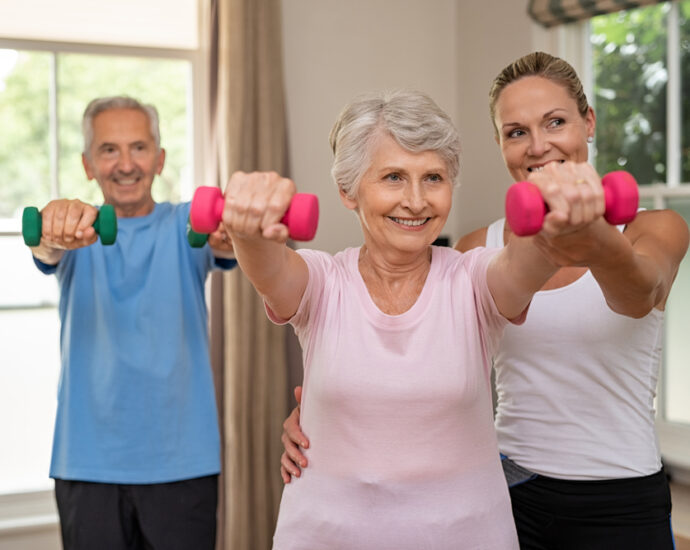As we age, maintaining flexibility becomes increasingly important for overall health and well-being. Flexibility, the ability of muscles and joints to move through their full range of motion, plays a key role in preventing injuries, enhancing mobility, and supporting functional independence. For individuals over the age of 50, focusing on improving flexibility can help promote vitality, reduce stiffness, and support an active lifestyle.
Page Contents
Effective tips and strategies for enhancing flexibility as you age:
- Incorporate Regular Stretching: One of the most effective ways to improve flexibility is through regular stretching exercises. Incorporate a variety of stretching techniques, including static stretches (holding a stretch for a period of time), dynamic stretches (moving through a range of motion), and proprioceptive neuromuscular facilitation (PNF) stretches (involving contraction and relaxation of muscles). Focus on major muscle groups such as the hamstrings, quadriceps, calves, hips, shoulders, and back to improve overall flexibility and mobility.
- Practice Yoga or Pilates: Yoga and Pilates are excellent forms of exercise that emphasize flexibility, strength, and balance. Both practices involve a series of poses and movements that promote flexibility, stability, and mind-body awareness. Participating in yoga or Pilates classes specifically designed for older adults can help improve flexibility, reduce joint stiffness, and enhance overall physical function. Look for classes that cater to beginners or those with limited mobility to ensure a safe and supportive environment.
- Warm Up Before Exercise: Prior to engaging in physical activity or exercise, it is essential to warm up the body to prepare muscles and joints for movement. A brief warm-up routine that includes light cardiovascular exercise (such as walking or cycling) and dynamic stretching can help increase blood flow, loosen tight muscles, and reduce the risk of injury. Warming up before exercise can also improve flexibility and range of motion, making it easier to perform movements with greater ease and comfort.
- Stay Active Throughout the Day: Incorporating movement into your daily routine is key to maintaining flexibility and preventing stiffness. Avoid prolonged periods of sitting or inactivity by taking regular breaks to stretch, walk, or engage in light physical activity. Simple activities such as gardening, walking the dog, or practicing gentle stretches while watching television can help keep muscles and joints supple and flexible. Aim to move your body in various ways throughout the day to promote joint mobility and prevent tightness.
- Stay Hydrated and Eat Well: Proper hydration and nutrition play a vital role in supporting flexibility and joint health. Staying hydrated helps maintain the elasticity of connective tissues, while consuming a balanced diet rich in vitamins, minerals, and antioxidants can support overall musculoskeletal health. Include foods high in omega-3 fatty acids (such as fatty fish and nuts), vitamin C (found in citrus fruits and leafy greens), and magnesium (found in seeds, nuts, and whole grains) to promote flexibility and reduce inflammation in the body.
- Listen to Your Body: As you age, it is important to listen to your body and respect its limits. Avoid pushing yourself too hard or forcing your body into positions that cause pain or discomfort. Focus on gentle, gradual progress in your flexibility routine, respecting your body’s natural range of motion and flexibility. If you experience pain or persistent stiffness, consult with a healthcare provider or physical therapist for guidance on safe and effective ways to improve flexibility without risking injury.
In conclusion, improving flexibility over the age of 50 is a valuable investment in maintaining physical function, mobility, and quality of life. By incorporating regular stretching, practicing yoga or Pilates, warming up before exercise, staying active throughout the day, prioritizing hydration and nutrition, and listening to your body’s signals, you can enhance flexibility, reduce stiffness, and support healthy aging. Remember that flexibility is a lifelong journey that requires patience, consistency, and self-care to help you move with ease, grace, and vitality as you age.
Being flexible offers a wide range of health benefits, including:
- Improved Range of Motion: Flexibility allows joints and muscles to move freely through their full range of motion, enhancing mobility and reducing the risk of stiffness and discomfort.
- Injury Prevention: Flexible muscles and joints are less prone to strains, sprains, and other injuries, as they can better withstand sudden movements and physical stress.
- Better Posture: Enhanced flexibility can support proper alignment of the spine and joints, promoting good posture and reducing the risk of musculoskeletal imbalances.
- Reduced Muscle Tension: Flexibility helps alleviate muscle tightness and tension, leading to improved relaxation, reduced muscle soreness, and a greater sense of comfort.
- Enhanced Performance: Increased flexibility can improve athletic performance, agility, and coordination by allowing for smoother and more efficient movements during physical activities.
- Joint Health: Flexibility supports joint health by promoting lubrication, circulation, and range of motion, which can help reduce the risk of arthritis and joint degeneration.
- Stress Relief: Stretching and flexibility exercises can help release tension, improve circulation, and promote relaxation, leading to reduced stress levels and enhanced mental well-being.
- Improved Circulation: Flexibility exercises can enhance blood flow to muscles and tissues, supporting nutrient delivery, waste removal, and overall cardiovascular health.
- Enhanced Balance and Stability: Being flexible can improve balance, coordination, and stability, reducing the risk of falls and injuries, especially in older adults.
- Pain Relief: Increased flexibility can help alleviate muscle tightness, joint stiffness, and discomfort, leading to reduced pain and improved overall comfort.
Overall, prioritizing flexibility through regular stretching, mobility exercises, and mind-body practices can contribute to better physical health, performance, and quality of life. Incorporating flexibility training into your routine can support overall well-being and longevity by promoting optimal mobility, strength, and resilience in the body.
READ MORE: Bad Habits That May Be Contributing To Your Knee Pain
Sources:
https://www.webmd.com/healthy-aging/flexibility-after-50-60
https://healthsurgeon.com/fitness/chair-yoga-fitness-benefits/
https://www.watkinsfamilychiropractic.com/the-fountain-of-health-the-benefits-and-importance-of-staying-hydrated/#:~:text=Supports%20Joint%20Health%3A%20Proper%20hydration,key%20for%20optimal%20athletic%20performance.
https://www.arthritis.org/health-wellness/healthy-living/physical-activity/other-activities/tension-relieving-stretches
